|
Chemistry News Archive January 2011
|
Chemistry News January 2011
News of the year 2011 in the fields of chemistry and chemistry-related topics like biochemistry, nantechnology, medicinal chemistry etc.
Main focus: press releases, scientific research results and summaries of chemistry articles, that are published in chemistry journals.
Please send us a eMail to publish your press release here!
|
|
| | | Chemistry: |  |
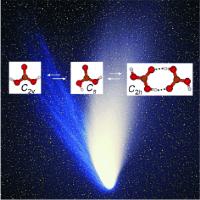 |
Carbonic acid: now isolated in the gas phase and examined spectroscopically. Against all odds: Carbonic acid molecules were trapped from the gas phase in a solid noble-gas matrix at < 10 K and studied by IR spectroscopy. The 2H and and 13C isotopologues were also examined [Source: Angewandte Chemie, Wiley-VCH]
|
 |
From molecule to object: largest synthetic structure with molecular precision. A 200×106 Da structurally defined, linear macromolecule (PG5) has a molar mass, cross-section dimension, and cylindrical shape that are comparable to some naturally occurring objects, such as amyloid fibrils or certain plant viruses [Credit: Angewandte Chemie].
|
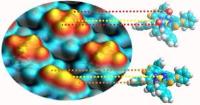 |
Scientists have deciphered the mechanism for binding of gas molecules to iron and cobalt porphyrins. A scanning tunneling microscopy image (left) shows four porphyrins. The models (right) illustrate the two systems shown in the picture. The protrusions correspond to the central atom (yellow sphere) and the two elevated portions to the saddle (orange) [Graphics: Chair E20-TUM].
|
|
Triblock spheres provide a simple path to complex structures.
|
| | | Biochemistry: |  |
 |
Scripps Research chemist devises new method to quantify protein changes. New process could advance study, treatment of various diseases including cancer. Image: The new technique mentioned in the title - short ICDID - enables quantification of sulfenic acid modifications in proteins [Credit: Angewandte Chemie International Edition].
|
|
Scientists have invented a way to 'watch' proteins fold - in less than thousandths of a second - into the elaborate twisted shapes that determine their function.
|
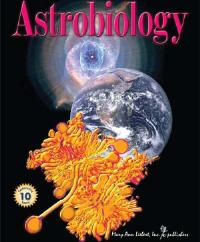 |
New answers to an age-old question: special collection of essays [open access] in the journal Astrobiology. Image: Astrobiology is the authoritative resource for the most up-to-date information and perspectives on exciting new research findings and discoveries emanating from interplanetary exploration and terrestrial field and laboratory research programs [© Mary Ann Liebert Inc. publishers].
|
|
Stretching the truth: JILA biophysicists help unravel DNA stretching mystery.
|
|
Defense mechanism against bacteria and fungi deciphered.
|
|
A wider range of asteroids were capable of creating the kind of amino acids used by life on Earth, according to new NASA research.
|
| | | Chemistry and Medicine: |  |
|
Weizmann Institute scientists have uncovered the presence of a chemical signal in emotional tears.
|
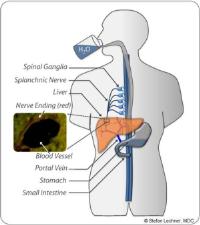 |
MDC researchers and clinical partners identify mediator of blood pressure regulation in the liver. Image: Pressor Reflex Triggered by Water Intake.pdf In humans, a pressor reflex is triggered simply by drinking tap water. After passing through the esophagus and stomach, the water is absorbed by the small intestine and is then swept on towards the liver in portal vein blood. MDC-scientists and their clinical partners have now found a new population of osmoreceptors in the liver, which detect the slightest physiological shifts in blood osmolality, a specific measure of the human water balance. If the osmolality decreases below its set point, the osmoreceptors send an electrical signal. This signal triggers an action potential, which in turn stimulates the hepatic vessels to raise blood pressure [Graphic: Dr. Stefan Lechner/ Copyright: MDC].
|
| | | Chemistry and Materials: |  |
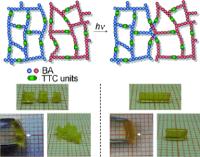 |
It heals and grows together: polymer with amazing self-healing properties. Polymers cross-linked with trithiocarbonate (TTC) units were prepared by a RAFT polymerization. The repeatable self-healing systems or macroscopic fusions were accomplished by UV irradiation of the cross-linked polymer in solution and in the bulk state [Credit: Angewandte Chemie].
|
| | | Chemistry and Environment: |  |
|
Natural dissolved organic matter plays dual role in cycling of mercury.
|
 |
Eggs show arctic mercury cycling may be linked to ice cover. [Credit: D. Roseneau, US Fish and Wildlife Service]
|
|
No longer pining for organic molecules to make particles in the air. New work will help researchers refine atmospheric weather, climate models.
|
| | | Lab-on-a-Chip: |  |
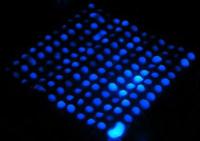 |
New lab-on-chip advance uses low-cost, disposable paper strips [Credit: Birck Nanotechnology Center, Purdue University].
|
| | | More News (open access): |
Secrets of plant warfare underpin quest for safer, more
secure global food supply
Like espionage agents probing an enemy's
fortifications, scientists are snooping out the innermost
secrets of the amazing defense mechanisms that plants use to
protect themselves from diseases. The effort - intended to discover ways of bolstering those
natural defenses and enhance the safety and security of the
global food supply - is the topic of
an article in the current edition of Chemical & Engineering
News (C&EN), ACS' weekly newsmagazine.
C&EN Associate Editor Sarah Everts notes
that plants use a battery of cunning mechanisms to protect
themselves from disease. When microbes breach those immune
defenses, epidemics like the Irish potato famine or wheat
stem rust can mean starvation and displacement for millions
of people.
The article describes how scientists are
intensively studying plant immune mechanisms. Over the last
20 years, for instance, scientists have made inroads into
the complex chemical architecture of those defenses. The
insights include the identification of a gene for the first
receptor protein involved in plant immunity as well as the
discovery of plant structures that recognize invading
microorganisms. Those and other insights could underpin
development of more effective and more sustainable ways of
fighting crop pests.
Chemical & Engineering News: "Vegetative
Warfare" [Volume 89, number 5, pp 53-55]. |
|
|



